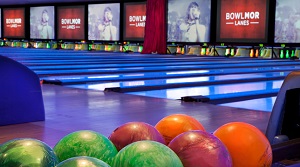Bowled Over: AV Injects New Life into an Old Pastime
By Dan Daley, Special to AVIXA
 Bowling isn’t what it used to be. Back from the1940s through the 1970s, the bowling alley was known as the “blue collar country club,” offering an accessible activity that was also a staple of weekend broadcast
sports. Even the White House had a two-lane alley installed in 1947. But bowling soon lost its luster, down to little more than 4,000 bowling centers in 2012 from almost 5,500 in 1998, a decline of 25 percent in 14 years.
Bowling isn’t what it used to be. Back from the1940s through the 1970s, the bowling alley was known as the “blue collar country club,” offering an accessible activity that was also a staple of weekend broadcast
sports. Even the White House had a two-lane alley installed in 1947. But bowling soon lost its luster, down to little more than 4,000 bowling centers in 2012 from almost 5,500 in 1998, a decline of 25 percent in 14 years.
Still, Tom Shannon had an idea. In 1994, the recently minted business school graduate stumbled upon a creaky bowling alley in New York’s Greenwich Village. Bowlmor had been there since 1938, but Shannon saw its future: bright lights, video screens, glow-in-the-dark lanes, better food, top-shelf drinks. By 1999, Bowlmor Lanes became the highest-grossing bowling alley in the United States.
Then Shannon and his staff quickly realized something else: A bowling alley is an attractive location for events of all kinds, from bar mitzvahs to corporate meetings. The central activity — bowling — was considered so uncompetitive that gutter balls were an occasion for good-natured laughter rather than shame, especially with a good drink in hand and surrounded by projection video and music.
“People usually went to clubs to socialize, but clubs are loud,” says Andres Restrepo, Bowlmor’s Director of Concept Development. “At Bowlmor, the music and lights were just as good, but not overpowering, and it didn’t matter how good a bowler you were — you were just there to have a good time.”
Event planners took notice and the upstairs space at Bowlmor was regularly filled by corporate and other events. Bowlmor’s original location, on University Place in a neighborhood now dominated by New York University, closed down last year, a victim of Manhattan’s manic real estate market. But it had already launched hundreds of progeny, each with its own sophisticated audio/video/lighting proposition.
The company decided to take the concept to multiple locations — Bowlmors in Washington, D.C.; Miami; Cupertino and Orange County, Calif. In 2010, when the 90,000-square-foot. Bowlmor Times Square opened in the former New York Times Building, it was hailed as the “Epcot of Bowling,” Throughout its expansion, the company made a strategic decision to maintain a high level of investment in audio, video and lighting in all of its locations, for both everyday bowling and event production. Bowlmor now operates more than 300 alleys after a merger with recreational equipment manufacturer AMF in 2013.
Big AV for Big Ideas
Bowlmor AMF, with 7,500 employees, is the largest operator of bowling centers in the world and it purchases a massive amount of AVL products every year. The Times Square flagship location, which has 50 lanes over two floors, had a $1.3 million budget for AVL and control when it opened. Bowlor is a big buyer of JBL speakers, Crown amplifiers, AKG wireless microphones, and AMX, Contro4 and Crestron control systems.
In some cases, the locations are themed. Bowlmor Times Square is the most elaborate, decorated to look like different neighborhoods and eras in the city’s history: The Chinatown room has a golden dragon and a giant gong to celebrate strikes; a subway-themed room comes with graffiti and subway grates; a Central Park-themed lounge features real fireplaces and memorabilia from the Tavern on the Green.
The Mar Vista, Calif., Bowlmor takes patrons through a 1970s vision of Southern California, with music through a 40,000-watt sound system. Each of these relies on tailored AVL to achieve their respective looks, says Restrepo.
Everyday patrons of Bowlmor are getting the benefit of a sound and light show that most nightclubs might envy. But, says Restrepo, it was the live-event production — particularly for corporate events — that convinced the company the power of audio, video and lighting to attract and build a venue-rental clientele and business.
DIY AV
Remarkably, the AVL systems at all Bowlmor locations are designed and installed by just the eight employees, who make up Bowlmor AMF’s AV department, led by Director Levan Natsvlishvili.
Natsvlishvili says that as his employees install audio, video, lighting and control systems in new locations — there will be over 30 of them this year alone — each bowling center facility manager gets trained in the systems’ operation, as well as basic troubleshooting and repair. When problems exceed the facility manager’s capabilities, they’re referred to Natsvlishvili and his staff.
As new locations are acquired, Natsvlishvili will assess each one’s layout and configure system designs to fit it. Then he’ll dispatch a team to do the installation, some of whom are based in various regions of the country where Bowlmor has locations. (In fact, it was an online classified ad for an AV specialist for Bowlmor in Texas that prompted this story.) In some cases, it makes more sense to use local AV integration vendors, but Bowlmor does all of its own ongoing equipment maintenance.
Although Bowlmore uses three brands of control system, all programmed by Natsvlishvili and his team to offer local managers an interface with a set of simple macros, programmed to call up the I/O configuration for everything from a DJ booth to a live band. “The AV design was meant to be reliable, user-friendly and cost effective,” he says.
Power of the Network
Managing and maintaining the AVL of this sprawling empire will become easier as more of the locations’ AVL and control systems join the 55 that are already are tied together onto the company’s IP network, which Natsvlishvili says will eventually connect every network-enabled device in any location and allow it to be monitored centrally.
This DIY philosophy dates back, Restrepo says, to the early days of the Greenwich Village location, where AVL rentals were eating up much of the revenue generated by event-space rentals.
“We figured out that we were leaving money on the table without our own AV systems,” he says. The savings across so many locations have been substantial, but, Restrepo says, much of the savings gets reinvested in more AVL systems and in higher-end brands. But if an extra piece of equipment is necessary to make a client’s wish come true, the company will rent it. The same applies for events that require complex audio mixing or video switching, in which case Bowlmor’s DIY team will bring in freelancers to run the systems.
“It’s a totally unique kind of place,” Restrepo says. “Whether it’s a birthday party or a corporate meeting, the AV and lighting knock everyone out.”




